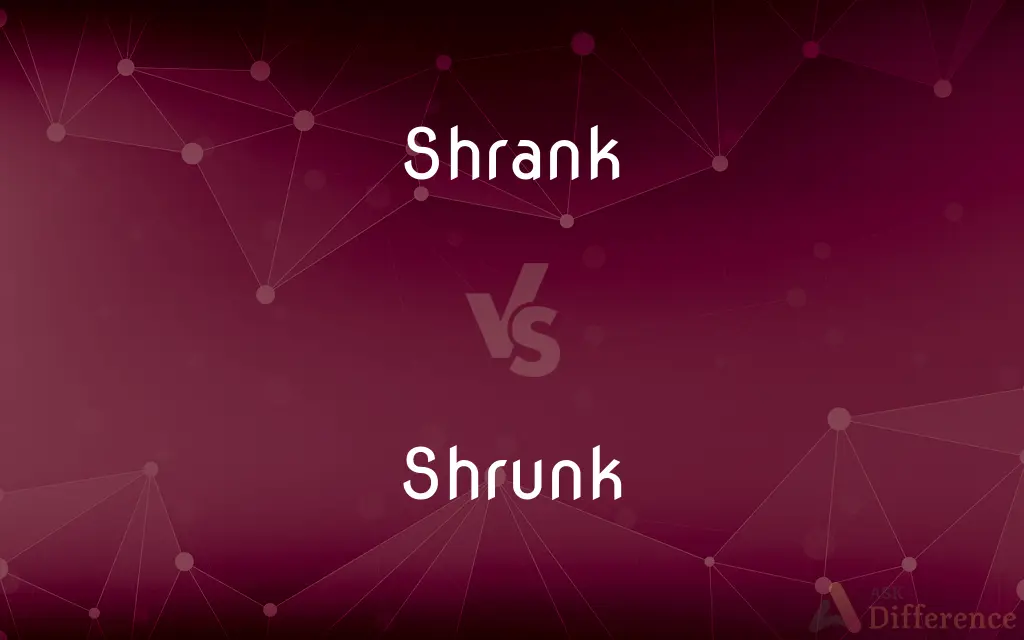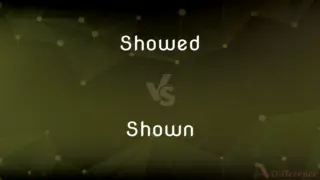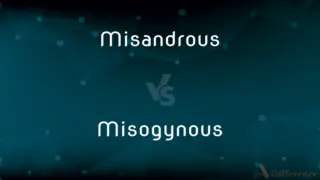Shrank vs. Shrunk — What's the Difference?
By Tayyaba Rehman & Fiza Rafique — Updated on April 29, 2024
Shrank is the simple past tense of "shrink," indicating a reduction that occurred in the past, whereas shrunk serves as the past participle, used in perfect tenses and passives.

Difference Between Shrank and Shrunk
Table of Contents
ADVERTISEMENT
Key Differences
Shrank is used to describe an action that was completed in the past. For example, you might say, "My sweater shrank after I washed it in hot water." Whereas, shrunk is typically used in conjunction with forms of have or be to indicate actions relating to shrinking that are completed or ongoing relative to other events, as in, "The sweater has shrunk.
"In typical usage, shrank directly follows a subject and a helping verb is not used, highlighting immediate past actions. Whereas shrunk is used in more complex tense constructions that provide a temporal or conditional relationship with other events, like "had shrunk" or "was shrunk.
"Shrank emphasizes a one-time, completed action within a narrative or recount. It succinctly marks a past event with no ties to the present. On the other hand, shrunk, especially when used as a past participle, often connects past actions to present consequences or states.
Shrank is straightforward and commonly follows a subject directly, making it simpler and more immediate in narratives. Conversely, shrunk often requires auxiliary verbs, creating a compound verb form that can express subtleties of time and aspect.
Usage of shrank is generally limited to the simple past, whereas shrunk appears in passive constructions and perfect aspect forms, demonstrating its versatility in expressing nuanced temporal relationships.
ADVERTISEMENT
Comparison Chart
Basic Form
Simple past
Past participle
Example Usage
"My jeans shrank."
"My jeans have shrunk."
Auxiliary Verb
None
Required (has, have, had)
Tense Simplicity
Direct and immediate
Complex, indicates duration or completion
Narrative Role
Describes a discrete past event
Connects past actions to present or future contexts
Compare with Definitions
Shrank
Reduction in size or amount in the past.
The fabric shrank after being washed.
Shrunk
Past participle of shrink, used with an auxiliary verb.
The document has shrunk to fit the page.
Shrank
To become smaller through some process.
His confidence shrank during the meeting.
Shrunk
To be diminished in importance.
His role in the project has shrunk.
Shrank
To recoil or withdraw.
She shrank from his touch.
Shrunk
To have withdrawn or pulled back.
They have shrunk back in fear.
Shrank
To decrease in value or importance.
Their share of the market shrank last year.
Shrunk
To have been reduced in size over time.
The workforce has shrunk since last year.
Shrank
To constrict physically.
The cold air made the balloon shrank.
Shrunk
To be lessened or reduced by a process.
Interest in the topic has shrunk.
Shrank
A past tense of shrink.
Shrunk
A past tense and a past participle of shrink.
Shrank
A large highly decorative German/Dutch-style piece of furniture, which combines aspects of a clothing wardrobe, curio, and cabinet.
Shrunk
Simple past tense and past participle of shrink
Shrunk
Shrunken
Shrunk
Reduced in size by being drawn together;
The shrunken dress was entirely too tight to wear
Common Curiosities
How do I know when to use shrank or shrunk?
Use "shrank" for simple past actions ("I shrank the shirt.") and "shrunk" in perfect tenses or passive voice ("The shirt has shrunk.").
What are examples of correct use of shrank?
"The jeans shrank in the dryer." This shows a completed action in the past.
Is it ever correct to say "The jeans are shrunk"?
It is grammatically correct in passive constructions, such as "The jeans are shrunk by the heat."
What is the main difference between shrank and shrunk?
"Shrank" is the simple past tense, used for direct past actions. "Shrunk" is the past participle, used with auxiliary verbs in perfect tenses and passive constructions.
What are examples of correct use of shrunk?
"The jeans have shrunk over time." This indicates the jeans reduced in size and the condition persists.
What does shrank imply in a narrative?
Shrank indicates a clear, concise past action without ongoing relevance.
What does shrunk imply about the timing of the action?
Shrunk implies an action with relevance to the present or a continuation from past to present.
Can shrank and shrunk be used interchangeably?
No, they serve different grammatical functions and are not interchangeable.
Does shrunk always need an auxiliary verb?
Yes, shrunk requires an auxiliary verb like has, have, or had to form perfect tenses.
Are there any exceptions to the general rules of shrank and shrunk?
Standard usage follows these rules, but colloquial or regional variations might exist where the terms are used less strictly.
Share Your Discovery

Previous Comparison
Showed vs. Shown
Next Comparison
Misandrous vs. MisogynousAuthor Spotlight
Written by
Tayyaba RehmanTayyaba Rehman is a distinguished writer, currently serving as a primary contributor to askdifference.com. As a researcher in semantics and etymology, Tayyaba's passion for the complexity of languages and their distinctions has found a perfect home on the platform. Tayyaba delves into the intricacies of language, distinguishing between commonly confused words and phrases, thereby providing clarity for readers worldwide.
Co-written by
Fiza RafiqueFiza Rafique is a skilled content writer at AskDifference.com, where she meticulously refines and enhances written pieces. Drawing from her vast editorial expertise, Fiza ensures clarity, accuracy, and precision in every article. Passionate about language, she continually seeks to elevate the quality of content for readers worldwide.













































